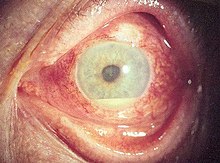| Uveitic Glaucoma | |
|---|---|
| Other names | Uveitis Glaucoma, Anterior Uveitic Glaucoma, Anterior Non-Infectious Uveitic Glaucoma, Uveitis Associated with Glaucoma, Iritic Glaucoma |
 | |
| Hypopyon in anterior uveitis, seen as yellowish exudation in lower part of anterior chamber of eye | |
| Pronunciation | |
| Specialty | Ophthalmology, optometry, immunology |
| Symptoms | Pain, blurry vision, headache, light sensitivity, eye redness, "floaters", decreased vision, blindness |
| Types | Visual impairment |
| Causes | Uveitis, Glucocorticoid treatment for uveitis |
Uveitic glaucoma (or uveitis glaucoma, or anterior uveitic glaucoma, or anterior noninfectious uveitic glaucoma, or uveitis associated with glaucoma, or iritic glaucoma) is most commonly a progression stage of noninfectious anterior uveitis or iritis.
Noninfectious anterior uveitis is an inflammation of the anterior (front) part of the eye and is instigated by autoimmune or other noninfectious causes (noninfectious uveitis can also affect the posterior segments of the eye, and then is called posterior, pan or intermediate uveitis). The onset of noninfectious uveitis occurs in patients in their thirties,[1] with up to 10% of cases diagnosed in children under the age of 16.[2][3] The condition may persist as a chronic disease.
Noninfectious uveitis is the most common form of uveitis in developed countries. Approximately 30% of uveitis patients develop glaucoma[4][5] as a result of the inflammation that occurs in uveitis, as a complication of steroid treatment[6] or a combination of both.[4]
Uveitis, as well as steroid treatment for uveitis, can cause an increased resistance to the flow of aqueous humour (the clear liquid suspended between the lens and the cornea) from the eye. This leads to an excess of fluid buildup, which exerts elevated pressure on the inside parts of the eye, or elevated intraocular pressure (IOP). Elevated intraocular pressure can in turn lead to optic nerve damage and glaucoma.
Based on epidemiological studies of uveitis, approximately 34-94/100,000 people will develop uveitic glaucoma (see Epidemiology section). Uveitic glaucoma patients are at significantly higher risk for visual field loss in the long term compared to patients who only have uveitis. Patients with uveitic glaucoma also experience a particularly high burden of care.[7]
- ^ Abdulaal, Marwan R.; Abiad, Bachir H.; Hamam, Rola N. (2015-05-18). "Uveitis in the Aging Eye: Incidence, Patterns, and Differential Diagnosis". Journal of Ophthalmology. 2015: e509456. doi:10.1155/2015/509456. ISSN 2090-004X. PMC 4452188. PMID 26090218.
- ^ Zierhut, Manfred; Michels, Hartmut; Stübiger, Nicole; Besch, Dorothea; Deuter, Christoph; Heiligenhaus, Arnd (2005). "Uveitis in children". International Ophthalmology Clinics. 45 (2): 135–156. doi:10.1097/01.iio.0000155903.87679.c2. ISSN 0020-8167. PMID 15791163. S2CID 220573163.
- ^ Päivönsalo-Hietanen, T.; Tuominen, J.; Saari, K. M. (February 2000). "Uveitis in children: population-based study in Finland". Acta Ophthalmologica Scandinavica. 78 (1): 84–88. doi:10.1034/j.1600-0420.2000.078001084.x. ISSN 1395-3907. PMID 10726797.
- ^ a b "Uveitic Glaucoma - EyeWiki". eyewiki.aao.org. Retrieved 2022-03-04.
- ^ "Uveitic Glaucoma". Uveitis.org | OIUF. Retrieved 2022-04-28.
- ^ Armaly, M. F. (October 1963). "Effect of Corticosteroids on Intraocular Pressure and Fluid Dynamics". Archives of Ophthalmology. 70 (4): 482–491. doi:10.1001/archopht.1963.00960050484010. ISSN 0003-9950. PMID 14078870.
- ^ "Homepage". Uveitic Glaucoma. Retrieved 2022-03-26.